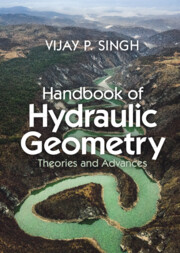Book contents
- Handbook of Hydraulic Geometry
- Handbook of Hydraulic Geometry
- Copyright page
- Dedication
- Contents
- Preface
- Acknowledgments
- 1 Introduction
- 2 Governing Equations
- 3 Regime Theory
- 4 Leopold–Maddock (LM) Theory
- 5 Theory of Minimum Variance
- 6 Dimensional Principles
- 7 Hydrodynamic Theory
- 8 Scaling Theory
- 9 Tractive Force Theory
- 10 Thermodynamic Theory
- 11 Similarity Principle
- 12 Channel Mobility Theory
- 13 Maximum Sediment Discharge and Froude Number Hypothesis
- 14 Principle of Minimum Froude Number
- 15 Hypothesis of Maximum Friction Factor
- 16 Maximum Flow Efficiency Hypothesis
- 17 Principle of Least Action
- 18 Theory of Minimum Energy Dissipation Rate
- 19 Entropy Theory
- 20 Minimum Energy Dissipation and Maximum Entropy Theory
- 21 Theory of Stream Power
- 22 Regional Hydraulic Geometry
- Index
- References
18 - Theory of Minimum Energy Dissipation Rate
Published online by Cambridge University Press: 24 November 2022
- Handbook of Hydraulic Geometry
- Handbook of Hydraulic Geometry
- Copyright page
- Dedication
- Contents
- Preface
- Acknowledgments
- 1 Introduction
- 2 Governing Equations
- 3 Regime Theory
- 4 Leopold–Maddock (LM) Theory
- 5 Theory of Minimum Variance
- 6 Dimensional Principles
- 7 Hydrodynamic Theory
- 8 Scaling Theory
- 9 Tractive Force Theory
- 10 Thermodynamic Theory
- 11 Similarity Principle
- 12 Channel Mobility Theory
- 13 Maximum Sediment Discharge and Froude Number Hypothesis
- 14 Principle of Minimum Froude Number
- 15 Hypothesis of Maximum Friction Factor
- 16 Maximum Flow Efficiency Hypothesis
- 17 Principle of Least Action
- 18 Theory of Minimum Energy Dissipation Rate
- 19 Entropy Theory
- 20 Minimum Energy Dissipation and Maximum Entropy Theory
- 21 Theory of Stream Power
- 22 Regional Hydraulic Geometry
- Index
- References
Summary
A river constantly adjusts its geometry and morphology in response to the water and sediment load it receives from its watershed and to human activities, such as straightening, dredging, cutoff, levee construction, restoration, and diversion. The adjustment requires dissipation of energy. When the energy dissipation reaches a minimum rate the river tends to reach equilibrium. This chapter discusses the theory of minimum energy dissipation rate for deriving the hydraulic geometry when the river is in equilibrium state.
Keywords
- Type
- Chapter
- Information
- Handbook of Hydraulic GeometryTheories and Advances, pp. 450 - 469Publisher: Cambridge University PressPrint publication year: 2022

